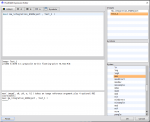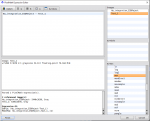So, I've recently gotten my trial account and was ready to get going…
I've read a couple of 'primers' and followed a tutorial for HaOSC combination (by The Elf), but despite having this super good and slow tutorial, it really is uphill.
As an engineer, I've used lots of complex software, but rarely had the feeling that the whole interface is made to fight you.
There are so many actions where I wonder why they didn't make it simpler, easier, or at least follow conventions.
It would be so easy to make a guided flow for the most common actions that almost everyone will take - And maybe allow you to save some parameters for your own setup.
I started out running the subframe selector on my Ha data (from my OSC) and it told me to use the absolute worst frames! I'm guessing because the stars were really small in G and B channels... Fortunately I discovered that myself, split the CFA from the whole group and then ran it again with better results…
A warning somewhere might have been nice.
An option to use only R/G or B channel? It might be in there, but worded to complex for me to spot it.
2 concrete issues that I had, that someone may help me understand.
1) Pixelmath. I'm trying to make an image out of the maximum pixel values from 2 images but get an error that the argument is not as expected. If I simply add them (Image1+Image2) then its fine but the max function max(Image1, Image2) fails. I can see others have used it... Has it been changed?
2) StarAlignment… I just wonder again why it has to be so complicated… My image was messed up, first as I chose a non-calibrated image as reference (no warnings or notes of any kind) and got checkerboards pattern all over. I managed to google other peoples frustrations and found the answer.
Next up, it messed up the stars in my Ha image. I didn't notice until an hours work later, but all the bigger stars in my Ha images got circles around them. I made a small study and found the issue with all the Lanczos algorithms, too big stars with the Mitchell-Netraveli and cubic-Bspline but the best result with Bicubic-spline. Of course nearest neighbour was perfect when viewed on single image basis, I didn't integrate all the stacks to see who made the best result.
I just wonder why there wasn't a button for NB images…
Or a pop-up saying this looks like a narrowband image, I suggest you use THIS…
Or even a warning in the mouse-over text?
Deepskystacker always ate whatever I threw at it, I never had such issues. Is there some other factor that I'm completely missing in Staralignment?
Strangely, my images are twice the resolution in X&Y after StarAlignment, I found no option or description of why. Thought it might be Drizzle, but no indication in the description here…
Well, if you read this far, then thank you for listening! I guess my frustrations are showing at this point... But still I hope I'll get to grips with PI within the trial period. So far, I spend about the same time getting to the same result with DSS+PS. If I can speed that up or learn to get an even better result, the value would show.
I've read a couple of 'primers' and followed a tutorial for HaOSC combination (by The Elf), but despite having this super good and slow tutorial, it really is uphill.
As an engineer, I've used lots of complex software, but rarely had the feeling that the whole interface is made to fight you.
There are so many actions where I wonder why they didn't make it simpler, easier, or at least follow conventions.
It would be so easy to make a guided flow for the most common actions that almost everyone will take - And maybe allow you to save some parameters for your own setup.
I started out running the subframe selector on my Ha data (from my OSC) and it told me to use the absolute worst frames! I'm guessing because the stars were really small in G and B channels... Fortunately I discovered that myself, split the CFA from the whole group and then ran it again with better results…
A warning somewhere might have been nice.
An option to use only R/G or B channel? It might be in there, but worded to complex for me to spot it.
2 concrete issues that I had, that someone may help me understand.
1) Pixelmath. I'm trying to make an image out of the maximum pixel values from 2 images but get an error that the argument is not as expected. If I simply add them (Image1+Image2) then its fine but the max function max(Image1, Image2) fails. I can see others have used it... Has it been changed?
2) StarAlignment… I just wonder again why it has to be so complicated… My image was messed up, first as I chose a non-calibrated image as reference (no warnings or notes of any kind) and got checkerboards pattern all over. I managed to google other peoples frustrations and found the answer.
Next up, it messed up the stars in my Ha image. I didn't notice until an hours work later, but all the bigger stars in my Ha images got circles around them. I made a small study and found the issue with all the Lanczos algorithms, too big stars with the Mitchell-Netraveli and cubic-Bspline but the best result with Bicubic-spline. Of course nearest neighbour was perfect when viewed on single image basis, I didn't integrate all the stacks to see who made the best result.
I just wonder why there wasn't a button for NB images…
Or a pop-up saying this looks like a narrowband image, I suggest you use THIS…
Or even a warning in the mouse-over text?
Deepskystacker always ate whatever I threw at it, I never had such issues. Is there some other factor that I'm completely missing in Staralignment?
Strangely, my images are twice the resolution in X&Y after StarAlignment, I found no option or description of why. Thought it might be Drizzle, but no indication in the description here…
Well, if you read this far, then thank you for listening! I guess my frustrations are showing at this point... But still I hope I'll get to grips with PI within the trial period. So far, I spend about the same time getting to the same result with DSS+PS. If I can speed that up or learn to get an even better result, the value would show.


